This was our 20th year fishing for salmon in the Copper River. You’d think we’d be experts by now and get our limit every time. Ha! If you want to be sure to come home with fish, go to the store. This fishery is a uniquely Alaska experience, a personal-use fishery open only to state residents. You use big nets on long handles. It’s a longstanding traditional way to harvest salmon for the table, and the fish, the Copper River red salmon, is probably one of the best food fishes in the world. We enjoy them immensely. And, while it’s serious work, I still enjoy going to get them.
I wrote up the procedures that we follow in fishing this way ten years ago, and they haven’t changed much. This year the charter operators, Mark Hem and Sam McAllister, began a new procedure on their end: two people per position on the river. With high water there are fewer spots, and they mentioned safety, as well. I was not eager to have to fish two permits from one spot in a slow year (the run was low), so we scheduled a time that looked like it might be good when both Rose and I could go.
It was mid-July, and we zoomed down to Chitina listening to a Rex Stout “Nero Wolfe” book on tape. It’s close to six and a half hours driving from Fairbanks. Once there, I dropped a life jacket in line for the next morning’s charter and walked around a bit to see how folks had been doing. There were fish being caught and cleaned, so it looked like we wouldn’t get skunked. We had some time left in the day, so I purchased a permit from Ahtna and went down to the river to do some sweeping. Here the current runs fast right up to the bank. To sweep, you heave the net in upstream, allow it to be swept down with the current, then lift it out, swing it back upriver, and plop it in again. Hard work. No fish. I gave it up after half an hour and we had dinner and went to be early.
There sure was a lot of noise in the night. People and their four-wheelers and slamming vehicle doors kept us company. I was able to mostly hug the rough wall of sleep without getting completely thrown off, but Rose wasn’t so lucky. And at 0230 the shrill low-battery alarm in the camper went off. I killed that and we slept a little longer, getting up at 0400. We’d made sandwiches the night before, so we just had coffee and a light snack and threw a few things together and got in the line for the boats with a bunch of other sleepy people.
Mark Hem counted folks off for the first two boats, gave us a rundown of how things worked, and collected our fees. Then we loaded and boarded. Daniel was our captain this morning, and he dropped us further down than we’d been before, not far outside the mouth of the canyon. This is in what we’ve called the “cowboy zone,” where boats roar upriver to a spot they like, then all aboard but the operator lean over and hold their nets over the side as the boat floats downriver. We hadn’t been down this way in years.
We had ourselves tied off and nets in the water very quickly. And so the long day began. Very slowly. We tried every position possible at this spot, but we caught few fish. Others weren’t doing very well either, apparently. But the weather was gorgeous, and Rose had made some great sandwiches, so we enjoyed the time on the river. As the soreness increased, that became more noticeable, though, so when the opportunity came to catch a ride back at ~1630 we took it. We’d fished hard all day, with both nets in the water almost constantly, but we’d only caught about one fish per hour. We threw two back—one was a large Dolly Varden char (which you are not allowed to catch by net), and the other was a red salmon that was too small for me. So we wound up keeping just nine fish, tying, I believe, our previous worst time ever. Not a great record to repeat in our 20th year of doing this.
But we were tired and sore and ready to go home. We gutted and iced the fish, packed up, and took the Nine Fish Express to Fairbanks. We stopped along the way at around 2100 to sleep with the fishes and finished the trip the next morning.
We felt beat up after our excursion. That many hours working a big net in a strong current is very hard work, and muscles you didn’t even know you had complain bitterly for the next couple days. I learned that despite feeling no pain there whatsoever during the actual effort, one should never use the arch of one’s foot to hold the net against a rock for hours. Or maybe I was doing it wrong 😉
Part 2. Double did one; single does double.
The combination this year of a low salmon run and high water had most people not getting their limits. This was either, like us, from just not catching fish, or, like most of the people we know in Fairbanks who usually go, not even trying because the reports were so poor. Rose thought we should stock up on a sale at the store rather than risk a second trip. I don’t find that to be as fun. Although neither is being stiff and sore for a couple days after not getting many fish. So I kept watching the reports, the shifting closure calendar (they close for varying lengths of time to ensure adequate escapement), and my calendar.
Our poor showing in mid-July left little time for a possible second trip to get more fish, though. A few weeks went by. The river kept on at high levels and the fishing was poor. And whether good or poor, the numbers of the salmon run always decline steadily as the season progresses. But one day I saw that the levels were falling, and better fishing was likely to happen after the final closure of the season so I dropped everything and went. One net and two coolers were eager to come with me. Long ago, we named our nets Mashie and Niblick after listening to numerous P. G. Wodehouse novels on former trips. I think it was Niblick that came along on this ride. We’ve also named our two 120-quart coolers, Ice Bearer and the S. S. Leaks Slowly.* I filled the former, our favorite, with ice on the way out of town and zoomed to Chitina with just one stop for gas.
After dropping my life jacket in line for the next morning’s charter, I walked around seeing how things had gone. Apparently they’d gone very well. Most people had already caught and cleaned their limits and left. Sam McAllister was on his boat and I talked with him a little. He said someone had actually gotten a seal in their net! Wow, would that ever be a netful of angry animal you wouldn’t want to handle. We see seal-bite marks in fish often (the ones that got away), but I haven’t seen a seal head poke up to look at us here ever.
I had some weird dreams that night, but it was quieter than last time, with fewer people present and less nocturnal activity. Nevertheless, I woke up at 0311 and couldn’t for the life of me get back to sleep. It was beautiful outside. The clouds had broken up and a partial moon was out lighting things up. Darkness still seems odd. But because it is dark again, the charter hours moved up an hour later, and so it was at 0545 that I was standing in line with a mixed group of fellow Alaskans hoping we’d get some fish. As we stood there, new snow could be seen on the nearest low peaks. Someone in the line called it “termination dust,” a phrase I think I’ve only heard once before. It was cool out; I was glad to have had a long-underwear shirt to put on.
Daniel dropped me alone on a spot I hadn’t fished before. It was a challenging place, not large enough for two. It was just an isolated rock in the canyon at the base of a steep cliff, separated from the cliff by a narrow channel a couple of feet wide on the shore side. It stuck up out of the water a few feet, and there was no way to tie off anything—me, the net, or stringers of fish. They left me with two fish buckets (standard plastic trash barrels) to put fish into. Apparently Mark Hem had fished this spot the day before, so I knew I’d probably catch fish. Daniel showed me how to fish the spot, and I was soon at it.
Boy, did it start slow. There was a slow back-current along about 10-12 feet of the lower side of the rock island. Mark had found it inconsistent with respect to position and depth of net, Daniel said, and that was sure the case. Eventually I had a very weak bump and had my first fish. Weak bumps proved to be the norm here for quite awhile, but at least I was steadily catching about one every 15 minutes. Oh, the water is absolutely opaque with a heavy silt load, so this is purely a by-feel exercise.
We all know that the fish like these back-currents, and that they concentrate where the back-currents interface with the normal, hard-charging downriver current. Here, this interface projected outward at a fairly steep angle from the rock, leaving mostly a wide, slow back-current to fish in. Because that was not producing many fish, I began to work the interface hard. This greatly increased the bump rate, and these tended to be big, hard bumps, but they also tended to bring me no fish at all, because they were happening on the outside of the net. At the interface, the net gets curled around by the conflicting currents. This was frustrating. At times I missed five or six bumps in a row. It was also harder work, requiring much more muscle to move the net or pull it out to check for fish or to straighten the net.
So I alternated between the two strategies. Whirlpools tended to be the most productive, so I’d fish those when they came by. I only ever picked up one of the fish that hit the outside of the net. It had twisted itself around a couple times and tightened a loop of net around its lower jaw, just barely holding it in place by tension and its sharp teeth. As it came to the surface I could see its naked body and was somewhat surprised that my hands and arms acted instantly and correctly to flip the net and get it in the bag before my brain quite caught up. As I hauled it in and the whole thing cleared the water I was pleasantly surprised to see that I’d done the whole thing perfectly.
When I’d gotten half the fish left on our permit (13 of 26), I stopped for a drink and a sandwich. It was 0930. It had been fairly cool, with a breeze blowing, but eventually the sun hit this narrow spot and that warmed things up. Happily, the increased light seemed to have no negative effect on fish movements. It had no positive effect either, though, so I kept fishing, racking them up at the same, slow-but-steady rate. With little space on this rock, my ballet was tightly choreographed. I brought each fish in the net to a particular spot on the rock that was fairly flat, so the ongoing wetness would not put a slippery spot in a dangerous place. I would then club the fish in the net once it slowed down enough for me to accurately brain it. I’d give each one 2-3 solid blows, because a thrashing fish out of the net here would be over the edge in a second. Next, I removed it from the net with a finger or two hooked through a gill, put down the club, and picked up the aviation shears. Then I stepped over to the edge of the rock where I was not fishing and clipped first a gill or two to bleed the fish and then the two tail corners, as required by law. Then I’d leave it laying to drain and stiffen while I continued to fish. With the next fish in hand, I’d lay the previous one in a barrel (which I initially had on their sides so they wouldn’t blow away, and which kept the fish mostly straight, which makes them easier to clean).
It was a pretty nice day. The gurgles and pops around the rock could occasionally be distracting over the larger noise of the river itself, and the view was a pleasant distraction from staring intently at the ever-changing currents. There was a nice waterfall on the opposite bank. A couple of times a strong whiff of wood smoke came by, and I idly wondered whether there was a secluded fairy castle tucked in some hidden nook nearby. Occasionally I could just spot one distant human fishing at the bottom of a landslide on the far bank. Otherwise, the only other humans were the boat operators every two hours or so.
I had another sandwich and a drink when I knew I was going to hit the limit. But most of the time I had the net in the water. I threw back something like four Dolly Varden and several small salmon. At 1300 I caught No. 26 and took some pictures before cleaning up. After packing up, I used a one-gallon ziploc bag to haul river water up to wash down the rock. It was a strain to get down to and back up from water level, so I was not able to begin cleaning fish. So I waited for a boat. When they came, they shuffled people from poorer spots to my spot and to that of another couple who’d gotten their limit, too. We were the first off the charters that day with our limits.
Back at O’Brien Creek, I put my gear into the truck and moved it closer to the cleaning tables. There, I unlimbered our second-favorite cooler and gradually put 13 cleaned fish into it. I humped that into the truck, iced them down, and brought out the Ice Bearer to take care of the second half. Then I loaded it all up, changed into street clothes (cooler and not bloody), hit the restroom (nice new ones this year), then hit the road. It was 1600.
I soon finished the second “Nero Wolfe” novel I’d brought on tape, and my final stretch enabled me to finish four chapters from The Annals of Tacitus, a history of Rome from ~14-68 AD written by Cornelius Tacitus. This was a particularly difficult time in Rome due to bad emperors. Seemed fitting. As I listened, I roared onward to the north, into the afternoon and evening and night, marveling at the unrest, strife, and big problems that truly bad leaders can cause and at how little has changed in this regard in the ensuing twenty centuries. I didn’t feel tired as I passed our favorite gravel pit, so I chose not to sleep with the fishes and instead continued on home, arriving there at ~2230. Long day. But good. There is something about having all that tasty fish headed for the freezer that makes you feel good all over.
* The S. S. in the S. S. Leaks Slowly stands for Substandard Shop, a tip of the hat to Click and Clack, the Tappet Brothers. This and the Ice Bearer are 120-qt coolers that have hauled a lot of fish. I keep them clean and maintained, but the old S. S. Leaks Slowly requires some plumber’s teflon tape on its screw-plug drain.

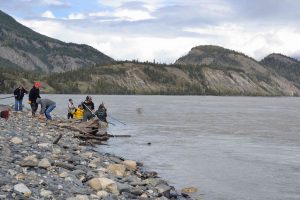
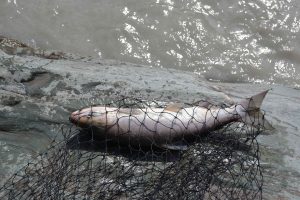
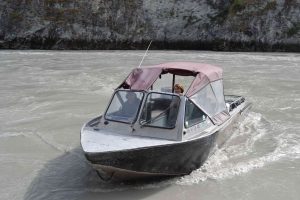
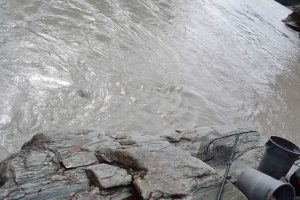
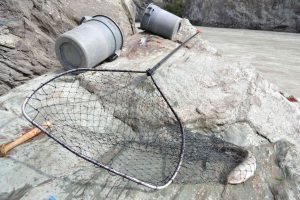
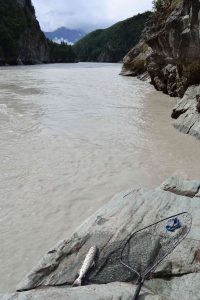
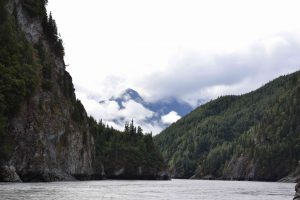
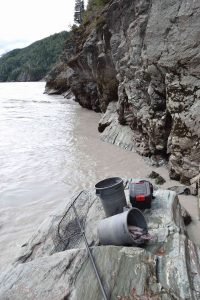
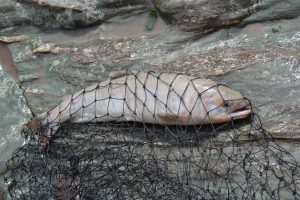
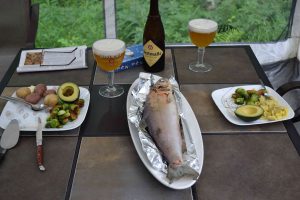
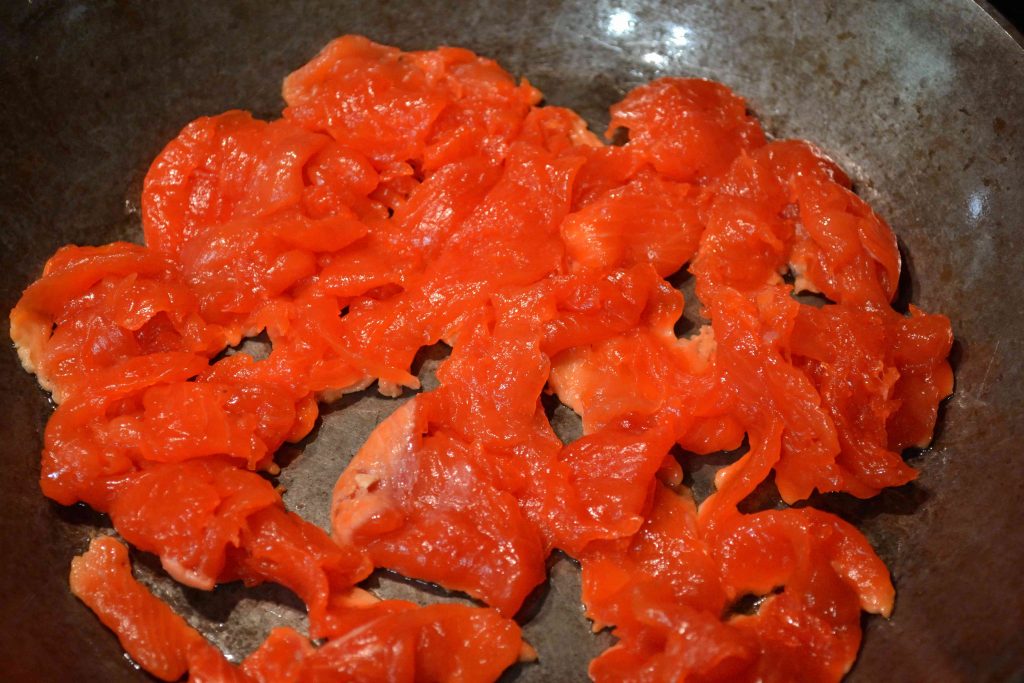
Glad you caught your limit. I like the grocery store sale idea better!
I didn’t realize salmon were so ugly, or maybe you didn’t get their good side.
…tasty? …wily? …sought after? …addictive?
This would be one of the great experiences when visiting Alaska. Too bad visitors aren’t allowed.
Visitors do come sometimes. But it’s pretty out-of-the-way, and there’s just not much space. I suspect I’d enjoy about a thousand other Alaska things more unless I could go out and get elbow deep in the whole process.